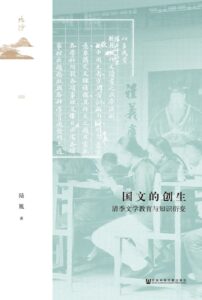
Lu Yin 陆胤
Beijing: Social Sciences Academic Press (北京:社会科学文献出版社), 2022
Reviewed by Lee Chee Yong (Ph.D. candidate of Hong Kong University of Science and Technology, HYI Visiting Fellow)
The question of “what literature is” often sparks interest in discussions within the field of humanities. While “literature” has become a word used worldwide to refer to fictional writings or belles-lettres, its historical nuances within the Sinosphere reveal a richer tapestry of textual production encompassing non-fictional writings and pedagogical endeavors aimed at enlightenment and edification.
In Professor Lu Yin’s seminal work, Making National Literature: Literary Education and Intellectual Evolution in Late Qing China, he delves into the transformation of Chinese literary discourse, particularly during the waning years of the Qing Dynasty (1894-1911). This era, centered on educational changes and shifts in knowledge, echoes the temporal scope explored in Douglas R. Reynolds’s China, 1898–1912: The Xinzheng Revolution and Japan. Following China’s defeat in the First Sino-Japanese War, issues concerning language and literary styles reemerged as crucial components of intellectuals’ reform agendas, making literary education a key focus in educational reform. Lu encapsulates the essence of this period as a stage of chuangsheng (创生) of national literature, drawing parallels to E.P. Thompson’s concept of “making” as depicted in The Making of the English Working Class, underscoring an active agency intertwined with contextual conditioning.
The book consists of a 64-page introduction and eight comprehensive chapters, where Lu meticulously investigates a myriad of primary sources, ranging from educational reform discussions and pedagogical methodologies to elementary school textbooks, classical text and poetry collections, anthologies in the name of “reader book,” grammar and rhetoric handbook, epistolary manuals, and beyond. Through a tripartite lens encompassing the revolution in the Chinese education landscape, the engagement of intellectuals in service of the masses, and the rising nationalism amidst Western and Japanese influences, Lu illuminates the intricate web of factors shaping the trajectory of Chinese literary evolution.
While the narrative highlights the government’s and intelligentsia’s efforts in formulating the national literature paradigm, one might be curious regarding the reaction and reception of these innovations among the populace, juxtaposed against traditional mores. Acknowledging the dearth of materials reflecting public reactions, Lu is nevertheless able to reconstruct the historical milieu of everyday life adeptly through his detailed textual analyses, which draw on a wide range of sources including diaries, correspondences, newspapers, lecture notes, and so on. He also provides comparative lists of school timetables, anthologies, and pedagogical materials as appendices, which offer a lucid exposition of the evolving literary landscape in that particular period.
Lu’s research contributes significantly to the field of Chinese literary studies by providing a deeper understanding of the intellectual evolutions and its intersection with educational reforms. This book provides inspiration and insight for scholars and enthusiasts interested in Chinese educational reforms, literary teaching, print culture, and everyday history. In short, this work invites readers on a captivating journey through a pivotal epoch in the development of Chinese literature and education.
